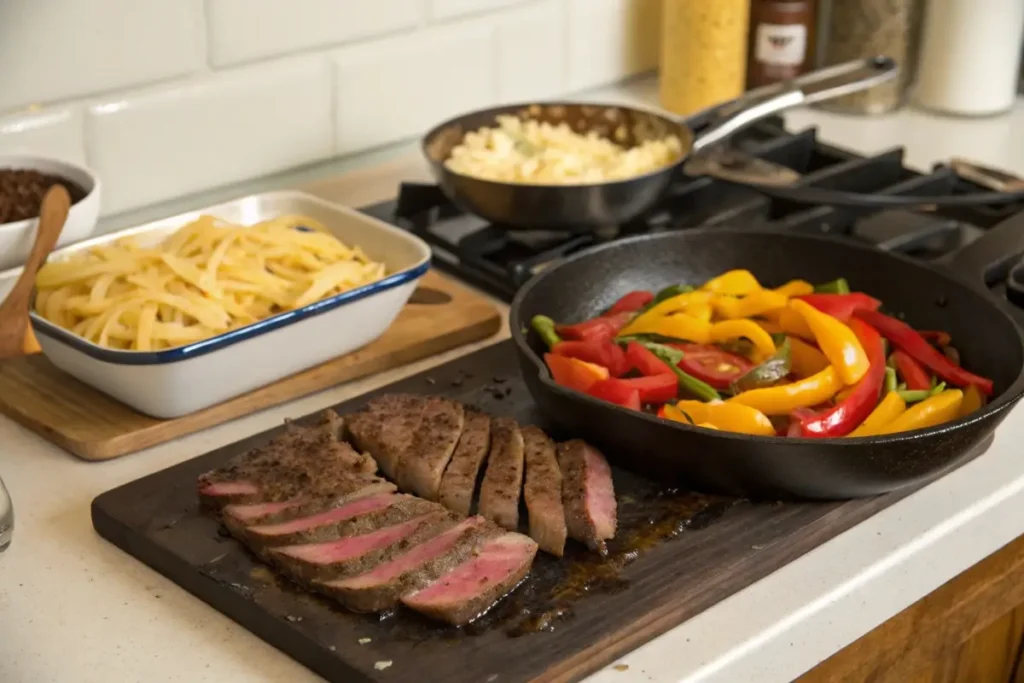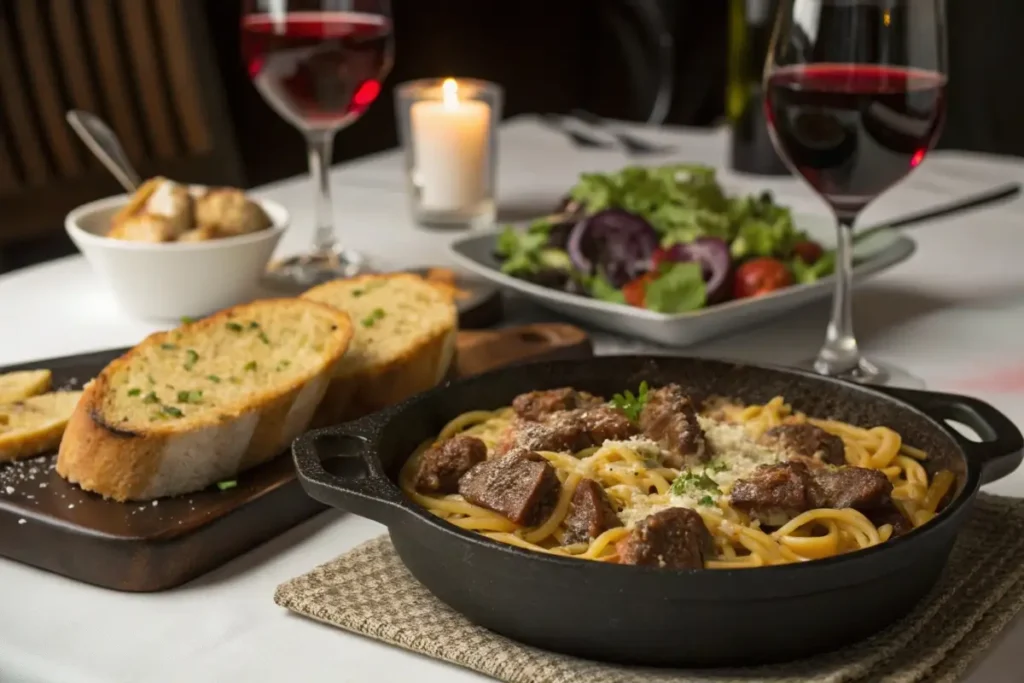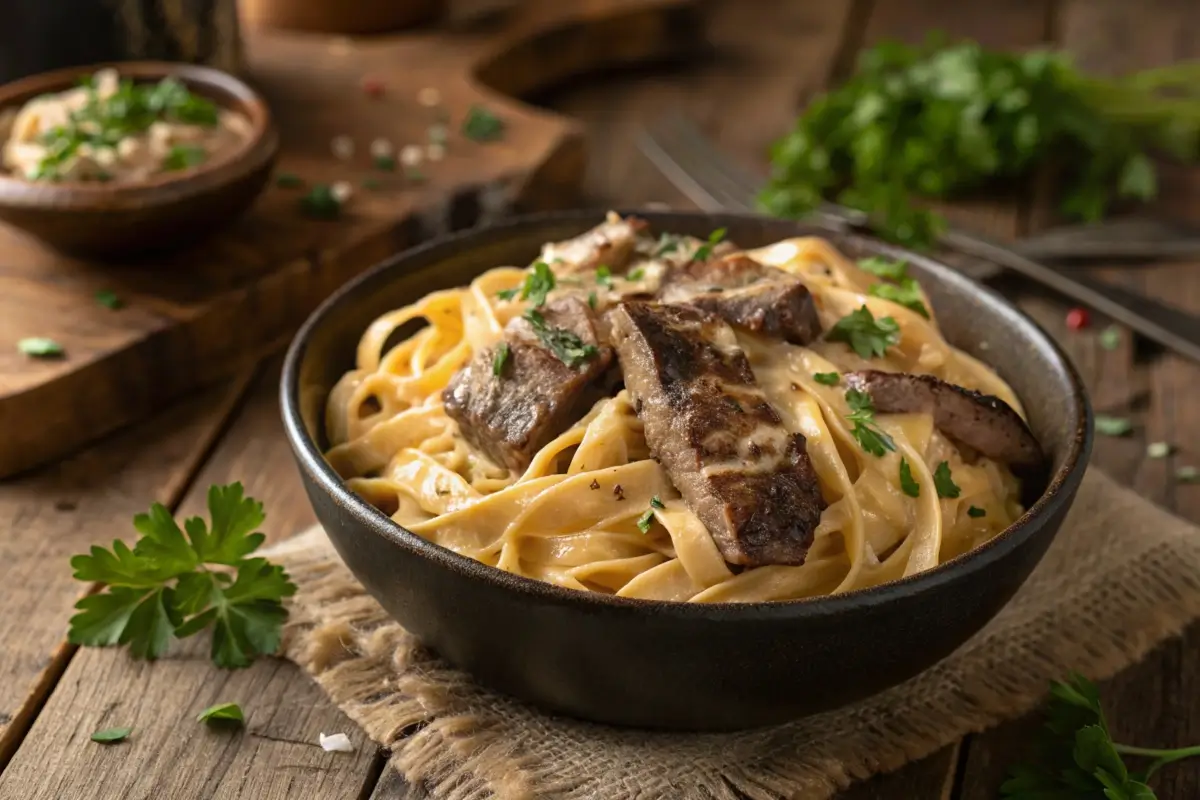Table of Contents
Steak and Cheese Pasta is the perfect combination of rich, savory flavors and creamy, cheesy goodness. This dish takes the best elements of a classic Philly cheesesteak—tender steak, melted cheese, and sautéed onions and peppers—and pairs them with perfectly cooked pasta for a hearty and satisfying meal. Whether you’re a home cook or just looking for an easy weeknight dinner, this guide will walk you through everything you need to know, from essential ingredients to expert cooking tips and delicious variations.
Introduction to Philly Cheesesteak Pasta
What is Philly Cheesesteak Pasta?
Philly cheesesteak pasta is a creative twist on the classic Philly cheesesteak sandwich. It takes the juicy steak, gooey cheese, and savory sautéed onions and peppers from the sandwich and incorporates them into a creamy pasta dish. This hearty combination has gained a cult following because it offers the best of both worlds—comfort food that’s indulgent yet easy to prepare.
The dish is a testament to the versatility of pasta, serving as a base for the rich and cheesy flavors of a Philly cheesesteak. It’s perfect for weeknight dinners, family gatherings, or even a cozy meal for two. The recipe can be adapted to suit various preferences, whether you prefer a creamier sauce, spicier seasoning, or a different cut of meat.
Key Ingredients That Define the Dish
The foundation of Philly cheesesteak pasta lies in its ingredients, each playing a crucial role in delivering the dish’s signature taste:
- Steak: Thinly sliced ribeye or sirloin works best, offering tenderness and flavor.
- Pasta: Shapes like penne, rigatoni, or rotini are popular as they hold the sauce well.
- Cheese: Provolone and cream cheese are classic choices, but you can use mozzarella, cheddar, or even a cheese sauce for extra creaminess.
- Vegetables: Bell peppers and onions bring a slightly sweet, smoky flavor, complementing the richness of the dish.
- Seasonings: Garlic powder, Worcestershire sauce, salt, and pepper add depth and aroma.
Whether you’re a beginner in the kitchen or an experienced cook, mastering these ingredients will set you up for success with this dish. The beauty of Philly cheesesteak pasta lies in its simplicity and versatility—feel free to make it your own!
Ingredients Overview and Substitutions
Essential Ingredients for Steak and Cheese Pasta
Crafting the perfect steak and cheese pasta starts with selecting high-quality ingredients. Each one plays a crucial role in delivering the creamy, savory flavors that make this dish irresistible:
- Steak: Thinly sliced ribeye or sirloin is ideal. These cuts are tender and flavorful, especially when pre-cooked with Worcestershire sauce for added depth.
- Pasta: Shapes like penne, rigatoni, or shells are perfect for holding onto the rich cheese sauce.
- Cheese: Provolone provides a sharp, tangy flavor, while cream cheese adds creaminess. For a melty finish, mozzarella or cheddar can be included.
- Vegetables: Sautéed onions and bell peppers add a smoky sweetness that complements the steak and cheese.
- Seasonings: Garlic powder, black pepper, and red chili flakes enhance the robust flavors of the dish.
These ingredients combine to create a classic steak and cheese pasta that’s both comforting and versatile.
Substitutions for Dietary Preferences
The flexibility of steak and cheese pasta makes it suitable for various dietary needs:
- Gluten-Free: Use quinoa or rice-based pasta. Ensure that all sauces and seasonings are gluten-free certified.
- Keto-Friendly: Replace pasta with zoodles or shirataki noodles for a low-carb version.
- Vegetarian: Substitute steak with hearty mushrooms or plant-based alternatives for a meatless twist.
- Dairy-Free: Use plant-based cheeses and a coconut milk-based sauce for a creamy yet dairy-free option.
Substitutions ensure everyone can enjoy this hearty steak and cheese pasta while accommodating their dietary preferences.
Step-by-Step Recipe for Steak and Cheese Pasta

Preparation: Getting Started
Before cooking steak and cheese pasta, gather your ingredients and tools. Essential items include a large skillet, a pot for boiling pasta, and a sharp knife. Begin by slicing the steak thinly, chopping onions and bell peppers, and shredding the cheese.
- Pro Tip: Allow the steak to come to room temperature for even cooking.
Cooking the Dish
- Cook the Pasta: Boil a pot of salted water and cook your pasta to al dente. Drain and set aside to prevent overcooking.
- Sauté Vegetables: Heat oil in a skillet over medium heat. Add onions and bell peppers, cooking until they become tender and slightly caramelized.
- Cook the Steak: Push the vegetables to one side of the skillet. Sear the steak slices over high heat until browned but not overcooked. Season with garlic powder, salt, and black pepper.
- Prepare the Sauce: Lower the heat and stir in cream cheese until melted. Gradually add heavy cream and shredded provolone, stirring until the sauce is smooth and creamy.
- Combine: Toss the cooked pasta into the skillet, ensuring the sauce coats every piece. Mix in the vegetables and steak, creating a perfectly balanced dish.
Serving Suggestions
Serve steak and cheese pasta hot, garnished with fresh parsley or a sprinkle of parmesan. Pair it with garlic bread or a crisp salad for a complete, satisfying meal.h green salad or buttery garlic bread for a complete meal.
Relevant internal link: Explore side pairings in our What Sides Go Well With Steak guide.
Tips and Tricks for Perfect Philly Cheesesteak Pasta
Cooking Tips from Experts
Creating the perfect Philly cheesesteak pasta involves a few handy tricks to ensure every bite is delicious:
- Choose the Right Cheese: For an authentic taste, use provolone or white American cheese. They melt smoothly and enhance the dish’s creaminess.
- Don’t Overcook the Steak: Cook the steak just until browned. Overcooking can make it tough and chewy, reducing the dish’s appeal.
- Layer the Flavors: Add Worcestershire sauce or a splash of beef broth to deepen the flavor profile.
- Cook Pasta Al Dente: Slightly firm pasta prevents it from becoming mushy when mixed with the sauce.
These expert tips are easy to follow and make a noticeable difference in the final result.
Common Mistakes to Avoid
Even simple recipes like Philly cheesesteak pasta can go awry without careful attention to details. Here’s what to watch out for:
- Using the Wrong Pasta: Avoid thin or delicate shapes like angel hair, as they can’t hold the rich sauce effectively.
- Skimping on Seasoning: Properly season every layer, from the steak to the sauce, to ensure a balanced taste.
- Skipping the Rest Time: Letting the dish sit for a minute or two after cooking allows the flavors to meld beautifully.
Following these guidelines ensures a consistent, flavorful dish every time.
Variations of Philly Cheesesteak Pasta
Classic vs. Modern Twists
The classic Philly cheesesteak pasta recipe sticks to its roots with traditional ingredients. However, adding a modern twist can make the dish uniquely yours:
- Classic Version: Ribeye steak, provolone, onions, and peppers combine for an authentic taste of Philadelphia.
- Modern Variations: Incorporate mushrooms for an earthy note or jalapeños for a spicy kick. Experiment with smoked gouda or cheddar for a bold, cheesy upgrade.
These simple changes allow you to explore new flavors while maintaining the dish’s essence.
Popular Regional Takes
Across the country, Philly cheesesteak pasta takes on regional flairs. For example:
- Southwestern Style: Add diced tomatoes, corn, and green chilies for a Tex-Mex vibe.
- Italian Fusion: Use marinara sauce and top with a sprinkle of parmesan for an Italian-inspired variation.
These regional adaptations make Philly cheesesteak pasta even more versatile and fun to cook.
Healthier Alternatives for Philly Cheesesteak Pasta
Lower-Calorie Variations
Transforming Philly cheesesteak pasta into a healthier dish is easier than you think. By making a few swaps, you can enjoy the same delicious flavors with fewer calories and less fat.
- Use Leaner Proteins: Replace ribeye with lean cuts like flank steak or ground turkey.
- Opt for Whole-Grain Pasta: Whole-grain or chickpea pasta adds fiber and nutrients while reducing empty carbs.
- Reduce Cheese: Use low-fat cheese options, or cut back on the amount of cheese in the sauce. A sprinkle of nutritional yeast can also add a cheesy flavor without the calories.
These tweaks allow you to enjoy a guilt-free version of this indulgent dish.
Vegetarian and Vegan Options
If you’re following a plant-based diet, there are still plenty of ways to enjoy Philly cheesesteak pasta.
- Protein Substitutes: Use portobello mushrooms or marinated tofu as a replacement for steak.
- Dairy-Free Sauce: Create a creamy sauce using cashew cream or plant-based milk thickened with a cornstarch slurry.
- Add Vegetables: Bulk up your dish with zucchini, spinach, or roasted red peppers for extra nutrients and texture.
Experimenting with these alternatives ensures that everyone at the table can savor this comforting dish.
Popular Serving and Presentation Ideas
Serving Suggestions for Every Occasion
Philly cheesesteak pasta is a versatile dish that can shine in various settings. For a casual weeknight dinner, serve it with a side of garlic bread or a fresh garden salad. Planning a dinner party? Present it in a large, elegant serving dish garnished with fresh parsley or grated parmesan.

Presentation Tips
How you plate Philly cheesesteak pasta can elevate the dining experience. Here are some simple yet effective ideas:
- Layer the Flavors: Arrange the pasta in individual bowls and top each serving with a few strips of seared steak and a sprinkle of shredded cheese.
- Family-Style Serving: For a rustic touch, serve the pasta straight from the skillet, letting the melted cheese and vibrant vegetables be the centerpiece.
- Add a Pop of Color: Garnish with fresh herbs like parsley or basil to brighten the plate and enhance the aroma.
These presentation ideas ensure that your dish looks as good as it tastes, making it a memorable part of any meal.
FAQs About Philly Cheesesteak Pasta
What is the best pasta to use for this recipe?
The best pasta for Philly cheesesteak pasta includes sturdy shapes like penne, rigatoni, or shells. These shapes hold onto the rich cheese sauce, ensuring every bite is packed with flavor. Avoid delicate options like angel hair, which can become overwhelmed by the hearty sauce and steak.
Can I make Philly Cheesesteak Pasta ahead of time?
Yes, you can! To make ahead, cook the pasta and sauce separately. Combine them just before serving to keep the dish fresh and creamy. Store the components in airtight containers in the refrigerator for up to three days. Reheat on the stove with a splash of milk or cream to revive the sauce’s consistency.
How do I store and reheat leftovers?
Store leftover Philly cheesesteak pasta in a sealed container in the fridge for up to three days. When reheating, use a skillet over low heat and add a splash of water or milk to prevent the sauce from drying out.
What are the best sides to serve with this dish?
Garlic bread, a crisp green salad, or roasted vegetables are excellent side dishes that pair beautifully with the rich flavors of Philly cheesesteak pasta. These sides balance the meal and add variety to the plate.
Conclusion and Final Thoughts
Why You Should Try Philly Cheesesteak Pasta
Philly cheesesteak pasta combines the bold, savory flavors of a Philly cheesesteak with the comforting texture of pasta. This dish is perfect for those who love hearty, satisfying meals that are easy to make and versatile. Whether for a weeknight dinner or a special occasion, this recipe is a guaranteed crowd-pleaser.
Encouragement to Experiment
The beauty of Philly cheesesteak pasta lies in its adaptability. Don’t hesitate to experiment with different cheeses, add unique vegetables, or even try alternative proteins like chicken or tofu. With a little creativity, you can transform this classic into a personalized masterpiece.
For more inspiration, explore recipes on our website, such as our guide to Steak and Pasta Combinations, to discover new ways to enjoy hearty meals.

